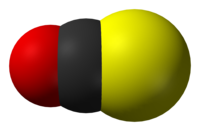Carbonyl sulfide
 |
|
 |
|
| Names | |
|---|---|
|
IUPAC name
Carbon oxide sulfide
|
|
| Identifiers | |
|
463-58-1 |
|
| 3D model (Jmol) | Interactive image |
| ChEBI |
CHEBI:16573 |
| ChemSpider |
9644 |
| ECHA InfoCard | 100.006.674 |
| EC Number | 207-340-0 |
| KEGG |
C07331 |
| PubChem | 10039 |
|
|
|
|
| Properties | |
| COS | |
| Molar mass | 60.075 g/mol |
| Appearance | colorless gas |
| Odor | sulfide-like |
| Density | 2.51 g/L |
| Melting point | −138.8 °C (−217.8 °F; 134.3 K) |
| Boiling point | −50.2 °C (−58.4 °F; 223.0 K) |
| 0.376 g/100 mL (0 °C) 0.125 g/100 mL (25 °C) |
|
| Solubility | very soluble in KOH, CS2 soluble in alcohol, toluene |
| -32.4·10−6 cm3/mol | |
| 0.65 D | |
| Thermochemistry | |
| 41.5 J/mol K | |
|
Std molar
entropy (S |
231.5 J/mol K |
|
Std enthalpy of
formation (ΔfH |
-141.8 kJ/mol |
| Hazards | |
| Safety data sheet | Carbonyl sulfide MSDS |
| NFPA 704 | |
| Explosive limits | 12-29% |
| Related compounds | |
|
Related compounds
|
Carbon dioxide Carbon disulfide |
|
Except where otherwise noted, data are given for materials in their standard state (at 25 °C [77 °F], 100 kPa).
|
|
|
|
|
| Infobox references | |
Carbonyl sulfide is the organic compound with the formula OCS. Commonly written as COS, it is a colourless flammable gas with an unpleasant odor. It is a linear molecule consisting of a carbonyl group double bonded to a sulfur atom. Carbonyl sulfide can be considered to be intermediate between carbon dioxide and carbon disulfide, both of which are valence isoelectronic with it.
Carbonyl sulfide decomposes in the presence of humidity and bases to carbon dioxide and hydrogen sulfide.
This compound is found to catalyze the formation of peptides from amino acids. This finding is an extension of the Miller–Urey experiment and it is suggested that carbonyl sulfide played a significant role in the origin of life.
Carbonyl sulfide is the most abundant sulfur compound naturally present in the atmosphere, at 0.5±0.05 ppb, because it is emitted from oceans, volcanoes and deep sea vents. As such, it is a significant compound in the global sulfur cycle. Measurements on the Antarctica ice cores and from air trapped in snow above glaciers (firn air) have provided a detailed picture of OCS concentrations from 1640 to the present day and allow an understanding of the relative importance of anthropogenic and non-anthropogenic sources of this gas to the atmosphere. Some carbonyl sulfide that is transported into the stratospheric sulfate layer is oxidized to sulfuric acid. Sulfuric acid forms particulate which affects energy balance due to light scattering. The long atmospheric lifetime of COS makes it the major source of stratospheric sulfate, though sulfur dioxide from volcanic activity can be significant too. Carbonyl sulfide is also removed from the atmosphere by terrestrial vegetation by enzymes associated with the uptake of carbon dioxide during photosynthesis, and by hydrolysis in ocean waters. Loss processes, such as these, limit the persistence (or lifetime) of a molecule of COS in the atmosphere to a few years.
...
Wikipedia

